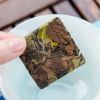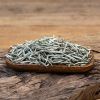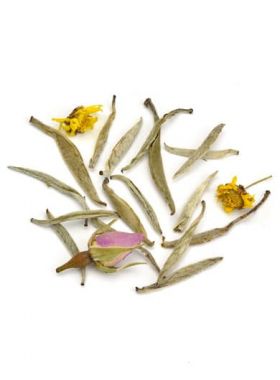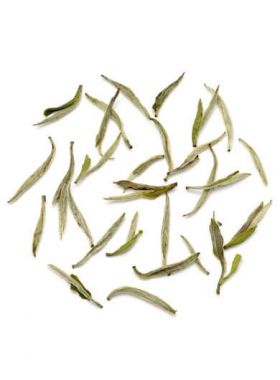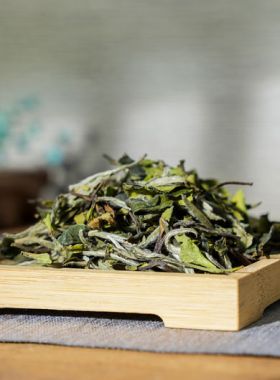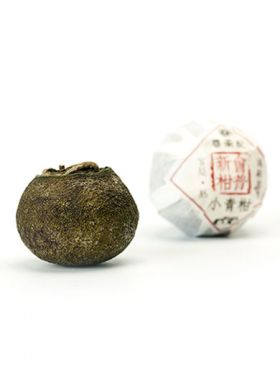-
Fast ShippingFree shipping for orders above $40
to most countries. -
Secure PaymentPay with Paypal, Credit Card …
-
Carefully SelectedFrequently Visit Tea Gardens.
Taste Repetitiously -
15 Days RefundNo Questions Asked
Refund Policy
Tangerine Peel (Chen Pi) White Tea
Orange flavor, sweet, soothing
Orange flavor, sweet, soothing
| Origin: |
Tea: Panxi Town, Fuding City, Fujian Province, China Tangerine peel: Xinhui City, Guangdong Province, China |
|---|---|
| Harvest Date: |
Tea: Aug. 18, 2019 Tangerine peel: 2018 |
| Production Date: |
May 16, 2023 |
| Net Wet: |
5g ± 1g |
| Dry Leaf: |
Brown leaves made into square biscuit shape, with tangerine peel stripes on the surface |
| Aroma: |
A fruity, citrusy aroma (think of orange flavored candy) |
| Liquor: |
Bright and clear orange in color |
| Taste: |
A strong scent of tangerine issuing from the peel, mixed with the aroma of white tea. Taste is sweet and subtle and quenches cravings. |
| Tea Bush: |
Fuding Dabaihao |
| Tea Garden: |
Hou Linggang Tea Garden |
| Caffeine: |
Low caffeine (less than 10% of a cup of coffee) |
| Storage: |
Store in cool, dry place away from sunlight; keep ventilated |
| Shelf Life: |
The aged the better |
Angel's Comment:
Chen pi strips mixed with white tea, taste very sweet and soft, very infusion enduring. Individually packed and easy to carry out.
This Tangerine Peel White Tea is made of white tea and tangerine peel into the shape of small biscuits. Each piece is about 5g±1g, which is convenient for storage. Different from our old style, which packed the tea leaves in a whole tangerine peel and made into a ball shape, the mini cake not only saves the trouble of prying tea, but also convenient to carry regardless of whether we are out or working.
It is common knowledge that tea leaves are highly absorbent and will pull in and store aromas from things in their surroundings, so storing the leaves inside the orange peel creates an authentic, uniquely-flavored tea that is both sweet and taste and retains the characteristic undertones of the orange.
 |
Cup Method |
 |
Chinese Gongfu Method |
 |
Teacup: 12oz / 355ml |  |
Gaiwan: 3.80oz / 110ml |
 |
203℉ / 95℃ |  |
203℉ / 95℃ |
 |
1 piece tea |  |
1 piece tea |
 |
Brewing time: 5 - 8 mins |  |
12 steeps: rinse, 25s, 30s, 15s, 20s, 30s, 40s, 50s, 60s, 70s, 80s, 100s, 120s |
| Rinse time is around 3 seconds |
This white tea is produced in Fuding, a famous tea production area located in the northeast of Fujian Province. Fuding is of the subtropical monsoon climate, characteristic to coastal areas; it experiences an average annual rainfall of about 1661mm, and the average annual temperature is right around 18.5C.

This white tea is made from the leaves of the Fuding Dabaihao plant, which propagates asexually and takes the form of a small tree. In 1985 it was certified as a national tea plant variety, and can grow up to 2.8m high with a thick trunk. The spring tea of this plant contains 1.8% amino acids ands 28.2% tea polyphenols, and is used to make high-quality white teas.

While tea was originally grown in the area around the city of Fuding, it later spread to the areas around the cities of Shuiji, and then Zhenghe. The first type of white tea produced was Silver Needle, in the area around Taimu Mountain.
Originally, Silver Needle tea was made from the buds of the Xiaobai variety of tea bush, a smaller and slower-growing variety; because of this, the tea was more expensive and harder to find. However, around 1857, farmers near Shuiji began using Dabaihao tea bush varieties, with larger buds and the capability to produce higher-quality tea, with more fuzz on the leaves and a stronger fragrance and taste. From that point on, Silver Needle, White Peony, and other types of white tea have been made using Dabaihao tea plant.
-
5 stars29
-
4 stars12
-
3 stars7
-
2 stars5
-
1 star0



